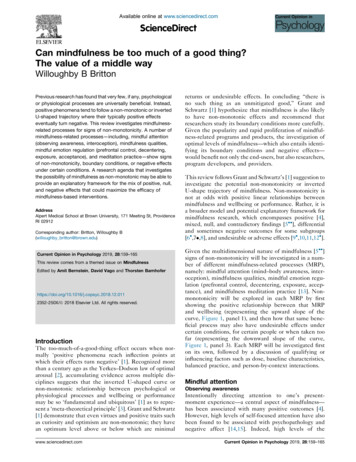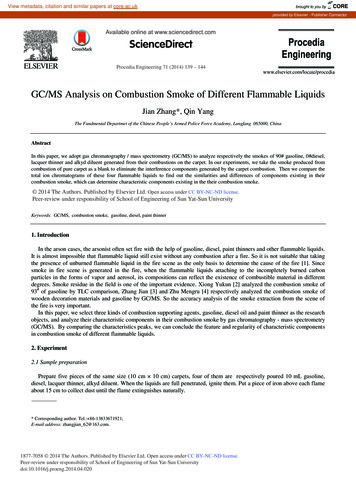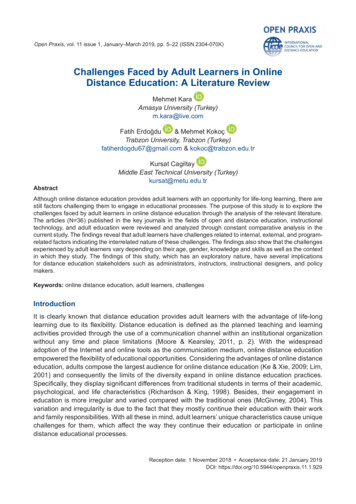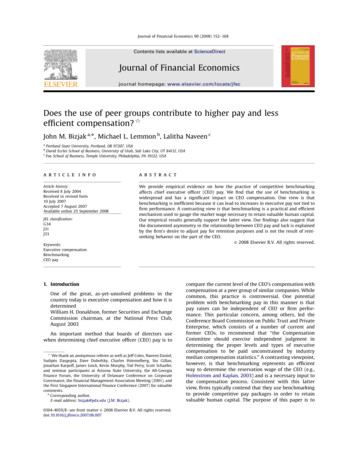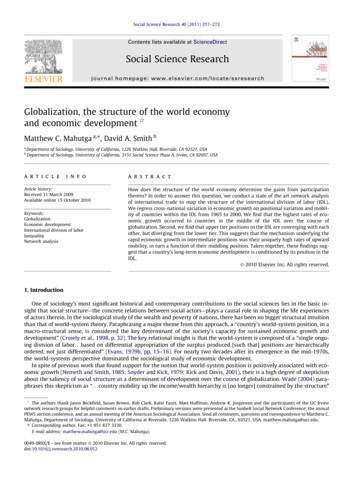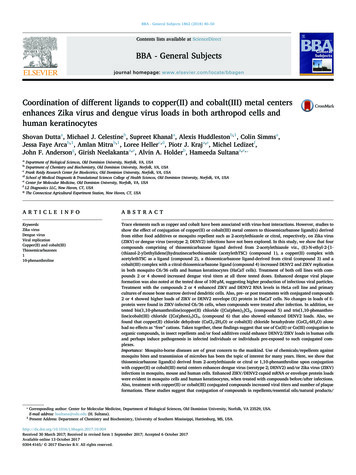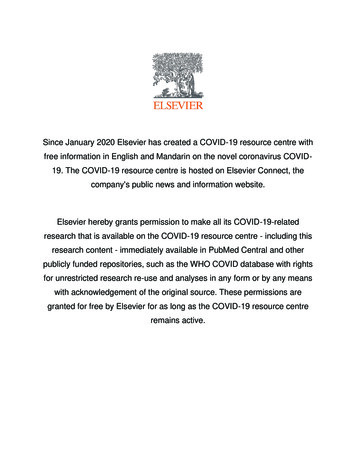
Transcription
Since January 2020 Elsevier has created a COVID-19 resource centre withfree information in English and Mandarin on the novel coronavirus COVID19. The COVID-19 resource centre is hosted on Elsevier Connect, thecompany's public news and information website.Elsevier hereby grants permission to make all its COVID-19-relatedresearch that is available on the COVID-19 resource centre - including thisresearch content - immediately available in PubMed Central and otherpublicly funded repositories, such as the WHO COVID database with rightsfor unrestricted research re-use and analyses in any form or by any meanswith acknowledgement of the original source. These permissions aregranted for free by Elsevier for as long as the COVID-19 resource centreremains active.
Available online at www.sciencedirect.comScienceDirectDocking approaches for modeling multi-molecularassembliesMireia Rosell1,2 and Juan Fernández-Recio1,2Computational docking approaches aim to overcome the limitedavailability of experimental structural data on protein–proteininteractions, which are key in biology. The field is rapidly movingfrom the traditional docking methodologies for modeling of binarycomplexes to more integrative approaches using templatebased, data-driven modeling of multi-molecular assemblies. Wewill review here the predictive capabilities of current dockingmethods in blind conditions, based on the results from the mostrecent community-wide blind experiments. Integration oftemplate-based and ab initio docking approaches is emerging asthe optimal strategy for modeling protein complexes andmultimolecular assemblies. We will also review the newmethodological advances on ab initio docking and integrativemodeling.Addresses1Barcelona Supercomputing Center (BSC), 08034 Barcelona, Spain2Instituto de Ciencias de la Vid y del Vino (ICVV), CSIC - Universidad deLa Rioja - Gobierno de La Rioja, 26007 Logroño, SpainCorresponding author:Fernández-Recio, Juan (juan.fernandezrecio@icvv.es)Current Opinion in Structural Biology 2020, 64:59–65This review comes from a themed issue on Biophysical and computational methodsEdited by Nagasuma Chandra and Gautam -440X/ã 2020 Elsevier Ltd. All rights reserved.IntroductionProtein–protein interactions are key for the majority ofbiological functions. Proteins can form highly specifictransient or permanent complexes that range from binarypairs to multi-molecular assemblies, often involving otherbiomolecules. A detailed structural knowledge of suchcomplexes at atomic level would improve our understanding of biological processes and facilitate intervention forbiomedical and biotechnological purposes. For example,recently reported structural data on the dynamic assemblyformed by the SARS-CoV-2 trimeric spike protein andthe cell receptor ACE2 are key to understand themolecular mechanisms of the virus infectivity and canwww.sciencedirect.combe essential for the development of new vaccines andtherapeutic candidates against COVID-19 [1 ,2 ,3].However, structural data is available for only a smallfraction of the protein interactome. For instance, the totalnumber of protein–protein interactions in human is estimated to range from 130 000 [4] to 650 000 [5], but lessthan 7000 of these interactions have available 3D structure (Interactome3D, 2019 1 version) [6]. In this context,computational docking approaches aim to overcome thelimited availability of experimental structural data. Sincethe first reported protein-protein docking algorithms inthe early 90’s, based on Fast Fourier Transform (FFT)sampling [7], the methodological developments havemostly focused on ab initio docking of binary complexes,starting from the structure of the unbound components.Some of the most popular methods are FTDock [8],ZDOCK [9] or MolFit [10]. The method HEX [11]and later FRODOCK [12] used polar Fourier correlationsto accelerate docking calculations. Other differentapproaches using stochastic search based on globalenergy optimization are ICM-DISCO [13,14], RosettaDock [15], HADDOCK [16], or SwarmDock [17].With the increasing availability of complex structures,in recent years attention is focused on template-basedstructural modeling of complexes, based the standardprinciples of homology-based modeling. The term template-based docking (as opposed to ab initio docking) isspecifically used when a model is built by superimposingthe structures (or models) of the unbound subunits ontothe corresponding subunits of a template complex structure [18]. One advantage is that template-based modelingcan be applied to multi-molecular complexes, not just tobinary complexes as ab initio docking. In addition, it hasbeen suggested that templates are available for the largemajority of cases in which interacting subunits havestructural information [19]. However, the general availability of good-quality templates that could be reliableused for template-based predictions seems much lower[20 ]. Actually, for the majority of known interactions,only templates with remote homology are available [4],for which direct application of template-based methodsleads to poor predictions [21]. Modeling multi-molecularassemblies implies additional challenges. For instance,some of the interfaces might not have available templates,in which case, we could model them by ab initio docking,in combination with restraints from evolutionary data orfrom available experimental information. Another challenge is to identify the relevant oligomerization state ofthe assembly when is different from that in the templateCurrent Opinion in Structural Biology 2020, 64:59–65
60 Biophysical and computational methods[22], in which case, alternative orientations provided byab initio docking can be very helpful. Modeling theconformational variability of the assembly componentsimposes an additional difficulty. Indeed, directlytaking the structure of a given subunit in another context(e.g. unbound state, different assembly or alternativeoligomerization state) might lead to inaccurate models.For this, it can be useful the application of protein-proteindocking and associated procedures, such as energyscoring, minimization, or flexible refinement.We will review here the predictive capabilities of currentprotein-protein docking methods in blind conditions,based on the results from the most recent CASP [23 ]and CAPRI [24 ] experiments. These tests show thatcombination of template-based and ab initio dockingapproaches is emerging as the optimal strategy for modeling protein complexes and multimolecular assemblies.We will also review the most recent methodologicalnovelties on ab initio docking, and new approaches forthe inclusion of experimental information and integrativemodeling.Predictive capabilities of computationaldocking: the state-of-the-artAb initio computational docking can provide acceptablemodels within the top 10 predictions in up to 40% of thecases, according to reported evaluation studies of different methodologies in current protein–protein dockingbenchmark version 5.0 [20 ,25,26].Traditionally CASP has been focused on the prediction ofthe structure of individual proteins. However, very oftenproteins are found as oligomeric assemblies, which addscomplexity to the modeling effort. To evaluate theapplicability of docking methodologies for the predictionof protein oligomeric assemblies, the last three CASPeditions included a CASP-CAPRI joint experimentfocused on multimeric assemblies, which are independently evaluated by CASP and CAPRI communities. Therecent CASP13-CAPRI challenge comprised a total of20 protein oligomeric assemblies, including 14 homocomplexes and 6 hetero-complexes, which could beclassified into 15 dimers and 5 multimeric assemblies[23 ]. In the 9 ‘easy’ targets, there were good structuraltemplates for the (partial or full) assembly, while for someof the remaining 11 ‘difficult’ targets, it was possible tofind remote templates for part of the assembly. Theavailability of templates in each case is critical to explainthe predictive success of the groups. Focusing on theresults for the top 10 predictions (to facilitate comparisonwith the reported performances of different dockingmethods in the literature), the best-performing groupsubmitted acceptable (or better) models for 13 targets(65% of the cases) (Figure 1). In the ‘easy’ targets, thebest-performing group submitted acceptable modelsfor all these cases, while in the ‘difficult’ targets, theCurrent Opinion in Structural Biology 2020, 64:59–65best-performing group submitted acceptable models foronly 4 of such targets (36% of the cases). Regardingthe quality of the models, high-quality models [23 ]were submitted by any group in 78% of the ‘easy’ targets(with template), but only in 9% of the ‘difficult’ targets(no template).On the other side, the recent 7th CAPRI edition showedmore heterogeneity in its targets, comprising 8 proteinprotein, 3 protein-peptide, and 5 protein-oligosaccharidecomplexes, all hetero-oligomers (except for a homodecamer), which could be classified in 10 dimers and6 multimeric assemblies [24 ]. The actual number ofevaluated targets was 19, because some of the interfacesin these multimeric assemblies were considered asindependent targets. There were structural templatesfor a total of 13 target interfaces (6 protein–protein,2 protein–peptide, and 5 protein–saccharide). This wasdeterminant for the overall predictive success of thegroups as well as for the quality of the predicted models.Overall, the maximum number of target interfacessuccessfully predicted by a single group was 13 (i.e.success in 68% of the cases) (Figure 1). But in cases withno available template, the best-performing groups submitted acceptable models for only 2 target interfaces (i.e.success in 33% of the cases). Regarding the quality of themodels, high-quality models [24 ] were submitted by anygroup in 31% of the ‘easy’ targets (with template) and in17% of the ‘difficult’ targets (no template). The 7thCAPRI edition showed that ab initio docking in casesfor which there is no available template is still highlychallenging, and progress is actually coming fromthe efficient procedures to combine template-basedmodeling and other docking methodologies.Combination of template-based and ab initiodockingThe CASP and CAPRI experiments show that templatebased modeling approaches are clearly the tools of choicewhen one can use templates of sufficient quality.However, very often only remote templates are available,which might not be good enough to provide reliablemodels, as above discussed [21]. In unclear situations, arelevant question is which method to choose, or how toefficiently combine these protein-protein dockingapproaches depending on each specific case [20 ]. Thisis even more relevant when modeling multimeric complexes, in which some interfaces might be modelledbased on homologous structures, while others would needab initio docking, as above mentioned. An updatedversion of the InterEvDock2 server [27 ] can performtemplate-based docking or ab initio docking withevolutionary constraints, depending on the case. Butthe question is still open about how to efficiently combinetemplate-based and ab initio docking when reliability ofthe template is unclear. We can obtain some hints fromthe recent CASP and CAPRI experiments.www.sciencedirect.com
Computational approaches to docking Rosell and Fernández-Recio 61Figure 1BM5PredictorsTotal7THCAPRICASP13TotalEasy DifficultPredictorsScorersTotal Easy otalTBNo-TBHighCurrent Opinion in Structural BiologyPredictive success rates of state-of-the-art docking approaches on different benchmark sets. ClusPro performance on Protein–Protein DockingBenchmark 5.0 (BM5) is taken from Ref. [20 ]. Performance of other docking methods on BM5 is taken from Ref. [26]. The rest of results are takenfrom CASP13-CAPRI and 7th CAPRI blind experiments. Sampling and scoring strategies included, but were not limited to: FFT-based sampling(ZDOCK, FTDock, ClusPro, Weng, Kozakov/Vajda, Shueler-Furman, Venclovas, pyDock, Fernandez-Recio, HDOCK, MDockPP, Zou, Shen, Seok),geometric hashing (Kihara, LZerD), particle swarm optimization (Bates), NMA-based sampling (Shen, Bates), information-driven sampling (Bonvin),energy-based scoring ( pyDock, Fernandez-Recio), machine learning-based scoring (IRaPPA, Shen), statistical potentials (Kihara, MDockPP, Zou),evolutionary-based scoring (Andreani/Guerois), Voronoi-based scoring (Venclovas), shape-based scoring (HDOCK), docking-based contactconsensus and residue propensities (Oliva, Carbone), and flexible refinement (Shueler-Furman, Seok).In the recent CASP13-CAPRI joint assembly predictionexperiment, one of the most efficient approaches was thatof Fernández-Recio, based on a combination of templatebased and ab initio docking followed by pyDock scoring[23 ], which ranked 2nd and 1st among all the CAPRIpredictors and scorers groups, respectively. Models forthe subunits were built by CASP-hosted servers. Then, abinitio docking was applied in all cases, using appropriatesymmetry constraints or interface restraints from literature. Additionally, when reliable templates were found,template-based models were built by superimposing allpossible models of the monomers onto them. After sortingall built models by pyDock scoring, the proportion oftemplate-based and ab initio docking models in the finalset of submitted models depended on the reliability of thetemplates (Figure 2). The difference with other methodologies was more evident on the ‘difficult’ cases for whichno clear template was available. For instance, in T154 abinitio docking by pyDock produced the only acceptablemodels among all participants. In T157, pyDock alsoproduced some of the few successful models of all groups.www.sciencedirect.comFor scorers, pyDock was used to evaluate all the proposedmodels, and in case of reliable templates, consistencybetween energy-based scoring and template-based datawas sought.In 7th CAPRI, predictions using template informationwere in general successful. Indeed, failing to use availabletemplates, as Fernández-Recio did in T122, T125 interface 1/4, and T133 targets, led to much worse predictions(although interestingly, this group was successful in thelatter target, using only ab initio docking). This shows thatit is critical to choose the optimal docking approach foreach case, depending on the template availability. In therest of targets, templates were used indirectly. In the twoprotein-peptide targets with good templates (T134,T135), ab initio docking with pyDock with restraints fromthe available templates was successful. In the six proteinsaccharide targets (T126-130), ab initio docking on thecavity identified from the available templates wasalso successful. These represent alternative strategiesto combine ab initio docking with template information.Current Opinion in Structural Biology 2020, 64:59–65
62 Biophysical and computational methodsFigure 2Input structuresX-rayTemplate-basedTemplate-based dockingAb-initio dockingCombinedX-ray templateAdding restraintsSymmetryEnergy-based scoringpyDockRSTpyDockTET (X-linking)pyDockSAXSFinal modelsFiltering by atom clashesRMSD-based ClusteringMinimization (AMBER12)Current Opinion in Structural BiologyAn example of the combination of template-based, ab initio docking and external data for integrative modeling of complexes. The scheme isbased on the strategy followed by our group (Fernandez-Recio) as predictors in the recent CASP13-CAPRI and 7th CAPRI experiments.Finally, in the scorers experiment, pyDock got the bestperformance when considering top 10 predictions, whichshows its capabilities to evaluate complex models derivedfrom combined approaches (template-based, ab initio,refinement) [24 ] (Figure 1).Novel methodological developments inprotein dockingThe most successful approach as predictor in CASP13CAPRI was that of Venclovas group. They basically usedtemplate-based models when reliable templates werefound, and free docking with HEX [11] otherwise. Oneof the reasons of their success could be the use ofVoroMQA [28] for the evaluation and selection of thefinal models. However, they were less efficient in thescorers experiment (rank 7th), which might indicate thatthis function seems mostly optimized for their ownpipeline for template-based and docking generation,while its application to models generated by other sourcesrepresents a challenge to be solved. Other successfulCurrent Opinion in Structural Biology 2020, 64:59–65approach was the use of CONSRANK [29,30] for theranking of docking models. CONSRANK is based on themost frequent inter-residue contacts in the ensembleof decoys, and has been updated to Clust-CONSRANKwith the addition of a recently developed clusteringprocedure [31]. The best-performing server inCASP13-CAPRI was HDOCK [32], from Huang’s group,who developed a new pairwise shape-based scoringfunction (LSC) for protein–protein docking to take intoaccount long-range interactions between proteinatoms [33 ].Other recent new developments in protein docking areRosettaDock 4.0, which shows improved predictions forflexible cases [34 ], LightDock, using glowworm swarmoptimization with NMA-based flexible search [35], orCIPS, a new scoring procedure [36 ] based on interfacepropensities from docking calculations. Docking interfacepropensities have interesting applications, such as interface prediction [37], and more recently, characterizationwww.sciencedirect.com
Computational approaches to docking Rosell and Fernández-Recio 63of multi-protein complexes in combination with otherevolutionary and physico-chemical properties [38].Use of external information for integrativedockingThe identification of correct docking poses often fails dueto intrinsic errors in current scoring functions, incorrectconsideration of oligomerization states, or because ofmultiple interfaces that are not usually included in dockingcalculations. For all these reasons, the use of externalinformation on a given complex is often critical for successful docking predictions. The pioneering HADDOCK [16],as well as other protein–protein docking methods, suchas pyDock [39], ZDOCK [40] or LightDock [4] havedeveloped procedures to include distance restraints toimprove the docking calculations. In this line, evolutionaryinformation can be a relevant source of information fordocking [42]. Indeed, the most successful dockingapproach in the recent 7th CAPRI edition was that ofthe Andreani and Guerois group. The challenging casesof this CAPRI edition encouraged them to go beyond theirtraditional rigid-body and InterEvScore approach, so theyapplied different strategies for the inclusion of evolutionaryconstraints, such as template-based modeling with RosettaCM-based protocol [43], identification of conservedanchoring interface motifs when only remote homologswere available, and covariation-based modeling ofinteracting subunits in cases in which traditional homology-based modeling would fail [44 ].In a broader sense, integrative computational approachesthat aim to efficiently use experimental structural data andadditional information from a variety of sources forthe structural modeling of complexes are becomingincreasingly popular [45]. One example is the integrationof Small-Angle X-ray Scattering (SAXS) experimental datain ab initio docking methods such as pyDock [46–48],HADDOCK [49], PatchDock [50,51], ATTRACT [52]or ClusPro [53]. And chemical cross-linking data has alsobeen integrated in protein docking methods such asZDOCK [54]. In the 7th CAPRI experiment, the use ofintegrative modeling approaches was blindly evaluated.Targets T150 and T151 were the same complex asT149, a challenging multi-domain dimer, for which SAXSand chemical cross-linking data were provided,respectively. Interestingly, the inclusion of restraints fromSAXS data improved the models submitted by pyDockfor the original target (with few successful groups),and the cross-linking data further improved pyDocksubmissions [55].ConclusionsThe most recent community-wide blind tests on thestructural prediction of multi-molecular assemblies andheteromeric protein complexes (including interactionwith peptides and saccharides) clearly showed that template availability, as well as any additional information onwww.sciencedirect.comthe complex, are critical for the modeling success. Severalgroups are focusing their efforts on developing newprocedures for efficient integration of template-basedand evolutionary information with ab initio dockingmethods, which are producing more accurate and realisticmodels. Additional methodological developments on protein docking include improvement of scoring functions,and better treatment of conformational flexibility duringdocking search, but the field is clearly moving towards anintegrative analysis and modeling of protein complexes.Conflict of interest statementNothing declared.AcknowledgementsThis work was supported by grant BIO2016-79930-R from the Spanish‘Programa Estatal I D I’, and EFA086/15 PIREPRED from the EUEuropean Regional Development Fund (ERDF) Program Interreg V-ASpain-France-Andorra (POCTEFA).Uncited reference[41].References and recommended readingPapers of particular interest, published within the period of review,have been highlighted as: of special interest of outstanding interest1. Lan J, Ge J, Yu J, Shan S, Zhou H, Fan S, Zhang Q, Shi X, Wang Q,Zhang L, Wang X: Structure of the SARS-CoV-2 spike receptorbinding domain bound to the ACE2 receptor. Nature 2020http://dx.doi.org/10.1038/s41586-020-2180-5. in pressThis manuscript reveals the 3D crystal structure of the SARS-CoV-2 spikereceptor-binding domain (RBD) bound to the cell receptor ACE2. Thestructural comparison with SARS-CoV RBD-ACE2 complex helps toidentify the critical residues for ACE2 binding, and bring new insightsinto convergent evolution between the SARSCoV-2 and SARS-CoV RBDsfor improved binding to ACE2. They also structurally analyze the epitopesof two SARS-CoV antibodies targeting the RBD, providing insights intothe future identification of cross-reactive antibodies.2. Walls AC, Park YJ, Tortorici MA, Wall A, McGuire AT, Veesler D:Structure, function, and antigenicity of the SARS-CoV-2 spikeglycoprotein. Cell 2020, 181:281-292This manuscript describes the cryo-EM structure of SARS-CoV-2 spikeectodomain trimer in two different conformational states, closed andpartially open (one SB domain open), providing new insights for the designof vaccines and inhibitors of viral entry. They found that the SARSCoV-2 Sglycoprotein harbors a furin cleavage site at the boundary between theS1/S2 subunits, which is not present in SARS-CoV and other SARSrelated CoVs, and can be relevant to understand the virus virulence.3.Wrapp D, Wang N, Corbett KS, Goldsmith JA, Hsieh CL, Abiona O,Graham BS, McLellan JS: Cryo-EM structure of the 2019-nCoVspike in the prefusion conformation. Science 2020, 367:12601263.4.Venkatesan K, Rual J-F, Vazquez A, Stelzl U, Lemmens I,Hirozane-Kishikawa T, Hao T, Zenkner M, Xin X, Goh K-I et al.: Anempirical framework for binary interactome mapping. NatMethods 2009, 6:83-90.5.Stumpf MP, Thorne T, de Silva E, Stewart R, An HJ, Lappe M,Wiuf C: Estimating the size of the human interactome. Proc NatlAcad Sci U S A 2008, 105:6959-6964.6.Mosca R, Ceol A, Aloy P: Interactome3D: adding structuraldetails to protein networks. Nat Methods 2013, 10:47-53.7.Katchalski-Katzir E, Shariv I, Eisenstein M, Friesem AA, Aflalo C,Vakser IA: Molecular surface recognition: determination ofCurrent Opinion in Structural Biology 2020, 64:59–65
64 Biophysical and computational methodsgeometric fit between proteins and their ligands by correlationtechniques. Proc Natl Acad Sci U S A 1992, 89:2195.8.Gabb HA, Jackson RM, Sternberg MJ: Modelling proteindocking using shape complementarity, electrostatics andbiochemical information. J Mol Biol 1997, 272:106-120.9.Chen R, Li L, Weng Z: ZDOCK: an initial-stage protein-dockingalgorithm. Proteins 2003, 52:80-87.10. Redington PK: MOLFIT: a computer program for molecularsuperposition. Comput Chem 1992, 16:217-222.11. Ritchie DW, Kemp GJL: Protein docking using spherical polarFourier correlations. Proteins 2000, 39:178-194.12. Garzon JI, Lopéz-Blanco JR, Pons C, Kovacs J, Abagyan R,Fernandez-Recio J, Chacon P: FRODOCK: a new approach forfast rotational protein-protein docking. Bioinformatics 2009,25:2544-2551.13. Fernández-Recio J, Totrov M, Abagyan R: Soft protein-proteindocking in internal coordinates. Protein Sci 2002, 11:280-291.14. Fernandez-Recio J, Totrov M, Abagyan R: ICM-DISCO dockingby global energy optimization with fully flexible side-chains.Proteins 2003, 52.15. Gray JJ, Moughon S, Wang C, Schueler-Furman O, Kuhlman B,Rohl CA, Baker D: Protein-protein docking with simultaneousoptimization of rigid-body displacement and side-chainconformations. J Mol Biol 2003, 331.16. Dominguez C, Boelens R, Bonvin AM: HADDOCK: a proteinprotein docking approach based on biochemical orbiophysical information. J Am Chem Soc 2003, 125:1731-1737.17. Moal IH, Bates PA: SwarmDock and the use of normal modes inprotein-protein docking. Int J Mol Sci 2010, 11:3623-3648.18. Szilagyi A, Zhang Y: Template-based structure modeling ofprotein–protein interactions. Curr Opin Struct Biol 2014,24:10-23.19. Kundrotas PJ, Zhu Z, Janin J, Vakser IA: Templates are availableto model nearly all complexes of structurally characterizedproteins. Proc Natl Acad Sci U S A 2012, 109:9438-9441.20. Porter KA, Desta I, Kozakov D, Vajda S: What method to use forprotein–protein docking? Curr Opin Struct Biol 2019, 55:1-7 This review reflects on the predictive capabilities of the different existingdocking approaches in view of their performance on Protein-ProteinDocking Benchmark 5.0 and the CASP11-CAPRI, CASP12-CAPRI and6th CAPRI blind experiments. On the basis of these results, they concludethat template-based methods yield more accurate predictions if goodtemplates can be found, but generally fail without such templates. Theargue that template-based docking for targets with good templates andfree docking for targets with worse templates is likely to increase thesuccess rates beyond 40%, which can be further improved by additionalrestraints from experimental information.21. Negroni J, Mosca R, Aloy P: Assessing the applicability oftemplate-based protein docking in the twilight zone. Structure2014, 22:1356-1362.22. Levy ED, Boeri Erba E, Robinson CV, Teichmann SA: Assemblyreflects evolution of protein complexes. Nature 2008, 453:12621265.23. Lensink MF, Brysbaert G, Nadzirin N, Velankar S, Chaleil RAG, Gerguri T, Bates PA, Laine E, Carbone A, Grudinin S et al.: Blindprediction of homo- and hetero-protein complexes: TheCASP13-CAPRI experiment. Proteins 2019, 87:1200-1221This manuscript describes the results for CAPRI Round 46, the third jointCASP-CAPRI protein assembly prediction challenge. The Round comprised a total of 20 targets including 14 homo-oligomers and 6 heterocomplexes. Eight of the homo-oligomer targets and one heterodimercomprised proteins that could be readily modeled using templates fromthe Protein Data Bank, often available for the full assembly. The remaining11 targets comprised 5 homodimers, 3 heterodimers, and two higherorder assemblies. These were more difficult to model, as their predictionmainly involved ‘ab-initio’ docking of subunit models derived from distantly related templates. A total of 30 CAPRI groups, including 9 automatic servers, submitted on average 2000 models per target. About17 groups participated in the CAPRI scoring rounds, offered for mosttargets, submitting 170 models per target. The prediction performance,Current Opinion in Structural Biology 2020, 64:59–65measured by the fraction of models of acceptable quality or highersubmitted across all predictors groups, was very good to excellent forthe nine easy targets. Poorer performance was achieved by predictors forthe 11 difficult targets, with medium and high quality models submitted foronly 3 of these targets. This experiment highlights yet again the unmetchallenge of modeling the conformational changes of the protein components that occur upon binding or that must be accounted for intemplate-based modeling.24. Lensink MF, Nadzirin N, Velankar S, Wodak SJ: Modeling protein protein, protein-peptide, and protein-oligosaccharidecomplexes: CAPRI 7th edition. Proteins 2019. (in press)This manuscript describes a summary of the seventh Critical Assessmentof Predicted Interactions (CAPRI) community-wide initiative. Performance was evaluated on the basis of 36 114 models of protein complexessubmitted by 57 groups-including 13 automatic servers-in predictionrounds held during the years 2016–2019 for eight protein-protein, threeprotein-peptide, and five protein-oligosaccharide targets with differentlength ligands. Models of acceptable quality, or better, were obtained fora total of six protein-protein complexes, which included four of thechallenging hetero-complexes and a homo-decamer. High accuracymodels were obtained for two of the three protein–peptide targets,and for one of the protein–oligosaccharide targets. The remaining protein–sugar targets were predicted with medium accuracy. This analysisindicates that progress in predicting increasingly challenging and diversetypes of targets is due to closer integration of template-based modelingtechniques with docking, scoring, and model refinement procedures, andto significant incremental improvements in the underlying methodologies.25. Vreven T, Moal IH, Vangone A, Pierce BG, Kastritis PL, Torchala M,Chaleil R, Jiménez-Garcı́a B, Bates PA, Fernandez-Recio J et al.:Updates to the integrated protein–protein interactionbenchmarks: docking benchmark version 5 and affinitybenchmark version 2. J Mol Biol 2015, 427:3031-3041.26. Moal IH, Barradas-Bautista D, Jiménez-Garcı́a B, Torchala M, vander Velde
Docking approaches for modeling multi-molecular assemblies Mireia Rosell1,2 and Juan Ferna ndez-Recio1,2 Computational dockingapproachesaimtoovercomethelimited .
